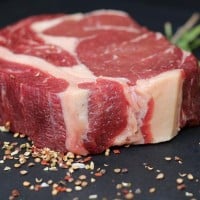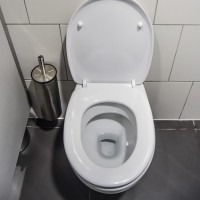Top 10 Best Ways to Conserve Water
Clean, drinkable water is our most precious resource, is finite in quantity, and is becoming more scarce as the world's population continues to increase. Until such time we develop the technology to cheaply desalinate ocean water or figure out how to smash together hydrogen and oxygen in the right proportions, conserving the clean water we do have is the best way to prevent shortages.Here are ten things ordinary people can do help conserve water. Some are easier than others, but all are a way to make a difference.
The Top Ten
1 Eat less red meat
 Farming livestock requires a shocking amount of water.
Farming livestock requires a shocking amount of water.
According to the USGS, it takes 10 gallons of water to produce 1 pound of chicken meat and 20 gallons of water to produce on chicken egg.
Compared to beef, that's nothing. The USGS states that it takes a whopping 600 gallons of water to produce 1 pound of hamburger. That means by replacing a single quarter pound burger with a chicken sandwich, you'd save enough water to take an hour long shower or flush your low flow toilet almost 100 times.
 Farming livestock requires a shocking amount of water.
Farming livestock requires a shocking amount of water.According to the USGS, it takes 10 gallons of water to produce 1 pound of chicken meat and 20 gallons of water to produce on chicken egg.
Compared to beef, that's nothing. The USGS states that it takes a whopping 600 gallons of water to produce 1 pound of hamburger. That means by replacing a single quarter pound burger with a chicken sandwich, you'd save enough water to take an hour long shower or flush your low flow toilet almost 100 times.
2 If it's yellow, let it mellow
 If you have the stomach for it, you can save a considerable amount of water by only flushing when there is something solid in the bowl. It is estimated that only 35% of flushes are "brown". Letting the yellow mellow can save the average person over 17,000 gallons of water per year.
If you have the stomach for it, you can save a considerable amount of water by only flushing when there is something solid in the bowl. It is estimated that only 35% of flushes are "brown". Letting the yellow mellow can save the average person over 17,000 gallons of water per year.
 If you have the stomach for it, you can save a considerable amount of water by only flushing when there is something solid in the bowl. It is estimated that only 35% of flushes are "brown". Letting the yellow mellow can save the average person over 17,000 gallons of water per year.
If you have the stomach for it, you can save a considerable amount of water by only flushing when there is something solid in the bowl. It is estimated that only 35% of flushes are "brown". Letting the yellow mellow can save the average person over 17,000 gallons of water per year. My mom gets mad when I do this.
But, mom! If it's yellow, you let it mellow. If it's brown, you flush it down!
3 Decrease the amount of water you use per flush
 The average person flushes 5 times per day. Modern toilets typically use about 1.5 gallons per flush (older toilets can use many multiples more). Some simple math gets us to over 2,700 gallons of water per year, per person that gets flushed away.
The average person flushes 5 times per day. Modern toilets typically use about 1.5 gallons per flush (older toilets can use many multiples more). Some simple math gets us to over 2,700 gallons of water per year, per person that gets flushed away.
Adjust your float to decrease the amount of water that gets stored in the tank or use more of a life hack approach and place something in the tank to take up space. Something as simple as placing an 8.4 oz Red Bull can in the tank will save almost 120 gallons of water per year and will likely have a negligible effect on flushing power.
 The average person flushes 5 times per day. Modern toilets typically use about 1.5 gallons per flush (older toilets can use many multiples more). Some simple math gets us to over 2,700 gallons of water per year, per person that gets flushed away.
The average person flushes 5 times per day. Modern toilets typically use about 1.5 gallons per flush (older toilets can use many multiples more). Some simple math gets us to over 2,700 gallons of water per year, per person that gets flushed away.Adjust your float to decrease the amount of water that gets stored in the tank or use more of a life hack approach and place something in the tank to take up space. Something as simple as placing an 8.4 oz Red Bull can in the tank will save almost 120 gallons of water per year and will likely have a negligible effect on flushing power.
4 Shower instead of taking a bath
An average bathtub holds about 36 gallons of water so if you have a water saving shower head, you'll use less water showering as long as you spend less than 18 minutes with the water running.
I just pretend there's a fish in the water, so that I don't do that and instead take a shower
5 Use a low flow shower head
Older shower heads use up to 5 gallons of water per minute. New shower heads get that number down to 2 gallons per minute. If you take a 10 minute shower every day, that results in a savings of almost 11,000 gallons per year.
6 Pre-rinse dishes less before putting them in the dishwasher
Often times, pre-rinsing is just a waste of time and water. Even worse, in modern dishwashers it can even negatively affect how clean your dishes get. Modern dishwasher detergent contains enzymes that are designed to attach to food particles. Pre-rinsing gives them less to attach to and can waste up to 30 gallons of water per load of dishes.
7 Get an EnergyStar rated washing machine
Older washing machines can use up to 40 gallons of water per load. You can decrease that by 15 gallons by getting a newer washing machine.
8 Turn off the sink when brushing teeth or shaving
It's not necessary to have the water running while the toothbrush is in your mouth or the razor is against you skin. Turning off the water when it's not in use can save a gallon or two per minute.
What kind of person leaves the sink running when they brush their teeth?
9 Harvest rainwater
Instead of letting it run down the drain, you can, for example, collect rainwater by using a rain barrel to capture precipitation from your rooftop. This water can then be used to water plants when things dry out again.
Be aware before harvesting water that you may be restricted by the water rights legislation in your area. Across the U.S., individual states have varying laws dictating who owns rainwater, who can collect it, how it can be collected, and what it can be used for. Take a moment to learn which laws may affect water harvesting in your area.
Be aware before harvesting water that you may be restricted by the water rights legislation in your area. Across the U.S., individual states have varying laws dictating who owns rainwater, who can collect it, how it can be collected, and what it can be used for. Take a moment to learn which laws may affect water harvesting in your area.
10 Xeriscape your yard
Grass is a very thirsty type of landscaping. A general rule of thumb is to make sure your lawn receives 1 inch of water per week during dry conditions, so a square foot of lawn will need 0.62 gallons of water per week. That may not seem like a ton, but it can add up quickly.
A tiny 10'x10' patch of lawn (slightly larger than 2 ping pong tables) will require 62 gallons of water per week. A tennis court sized patch of lawn (baseline to baseline including doubles alley) will require almost 1,750 gallons per week.
Replacing lawn with more hearty plants and non-living landscaping options can save a huge amount of water depending on your yard size and climate.
A tiny 10'x10' patch of lawn (slightly larger than 2 ping pong tables) will require 62 gallons of water per week. A tennis court sized patch of lawn (baseline to baseline including doubles alley) will require almost 1,750 gallons per week.
Replacing lawn with more hearty plants and non-living landscaping options can save a huge amount of water depending on your yard size and climate.
BAdd New Item